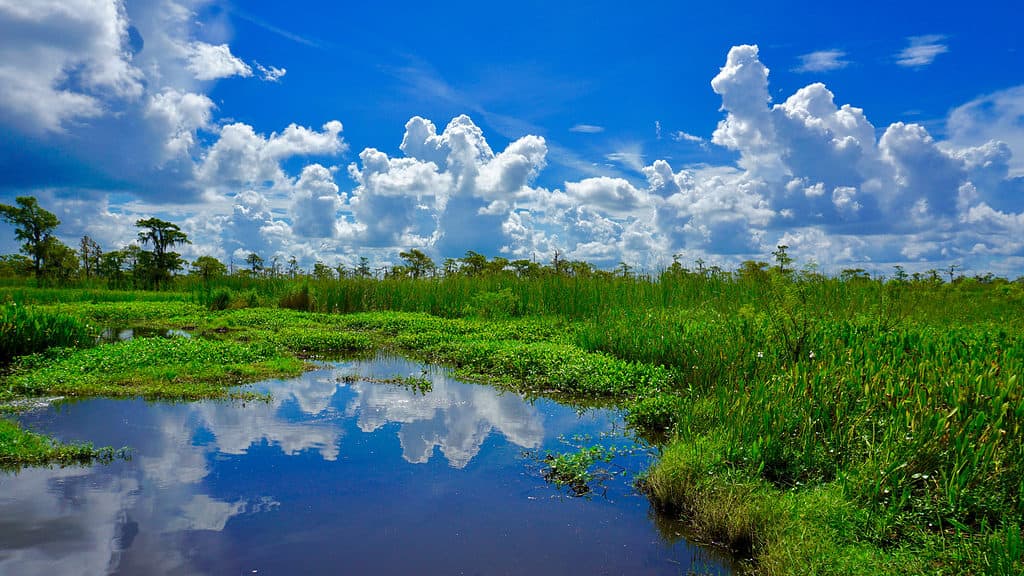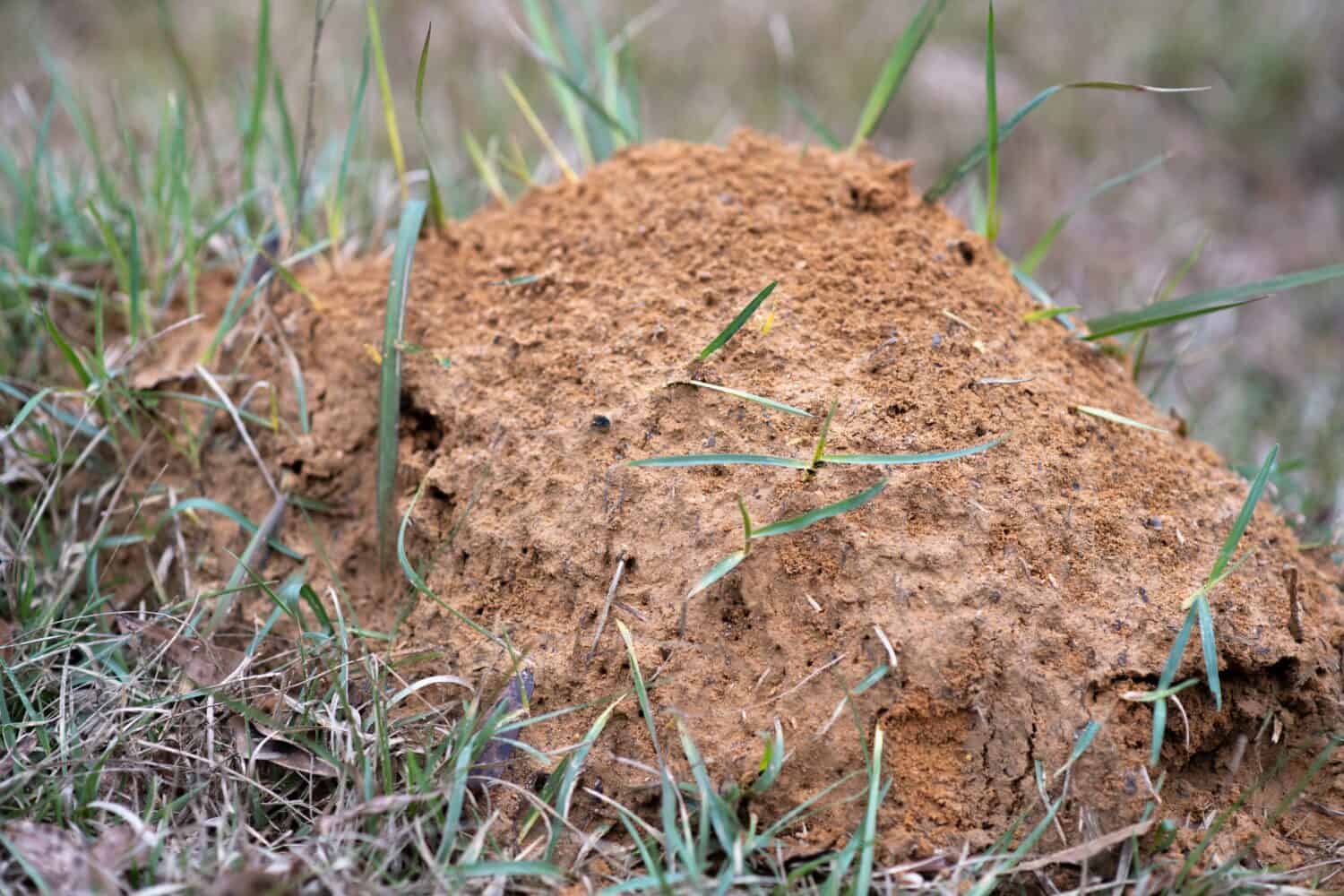Louisiana is known for its hot summers and very humid climate. One reason why Louisiana summers are so muggy is because of the Gulf of Mexico. The winds that come up from the Gulf sweep hot and humid air across the state. And because the summer months are generally the rainiest in Louisiana, this also contributes to the thick humidity. While Louisiana residents are prepared for high temperatures during the summer, the hottest temperature ever recorded was unbelievable.
Louisiana’s Average Temperatures

The hottest months in Louisiana tend to be June through August, and the hottest temperature ever recorded in Louisiana occurred in August!
©Josh Healy/Shutterstock.com
The average yearly temperature for Louisiana is 65°F. When you look at the average high for the state, however, that is around 76°F. And the average low for the state is 54°F. The hottest months in Louisiana tend to be June through August. So, it is no surprise that Louisiana’s hottest temperature was recorded in August!
In fact, Forbes magazine came out with a report citing that Louisiana has the most oppressive temperatures in the country. Because Louisiana has such light winds and high dew point temperatures during the summers, the state experiences uncomfortable heat. It was also noted that New Orleans and Shreveport are the two hottest places to live in Louisiana. However, neither of these cities holds the record for the hottest temperature ever recorded in Louisiana.
The Hottest Temperature Ever Recorded in Louisiana
The highest temperature Louisiana has ever seen occurred on August 10, 1936. On that day, people in Plain Dealing, Louisiana, experienced temperatures up to 114°F.
There are several factors why Plain Dealing experiences such hot temperatures. For one, its climate is considered subtropical, which is characterized by hot summers and mild winters. Also, with the town located on the northwest corner of Louisiana, it is far from water.
The Gulf, swamps, and wetlands in southern Louisiana help regulate the temperatures. The heat outside is absorbed through evaporation. This means more water vapor in the air, or humidity, which causes a higher heat index, but lower actual temperatures on extreme heat days. The heat index is what it “feels like” outside, taking the humidity into account.
However, because Plain Dealing is in northern Louisiana, there are fewer bodies of water to absorb the heat. This means that the north of the state experiences higher actual temperatures for more days than the south.
Sunlight also contributes to the number of hot days Plain Dealing experiences. The average amount of sunny days in the United States is 205 days. But Plain Dealing has 218 sunny days on average per year. The clear, sunshiny days mean more heat is reaching the ground, causing temperatures to increase.
How Our Bodies React to High Temperatures

While illnesses like heat cramps or heat rash may occur in extreme heat, you must also watch out for heat stroke.
©EugeneEdge/Shutterstock.com
Around 97°F to 99°F is the internal temperature our bodies like to stay at. If we get hotter than that, our bodies have several ways to bring the temperature down. The first is through sweat. As sweat evaporates off your body, your body cools down. Another way is by dilating your blood vessels and increasing your heart rate. That takes all the extra internal heat and brings it to the surface so that you can release the heat more efficiently.
But heat-related illness may occur in extreme temperatures like the hottest temperature ever recorded in Louisiana. While illnesses like heat cramps or heat rash may occur, you must watch out for heat stroke. This is when the body temperature reaches 104°F to 105°F. Your skin will look red, and your pulse will be rapid. Other symptoms include confusion, headaches, nausea, dizziness, or fainting. If you suspect you are experiencing heat stroke, seek medical attention, as heat stroke can lead to death if left untreated.
Animals That Thrive in Hot Temperatures
Just as residents have adapted to the scorching summers in Louisiana, animals have adapted as well. Here are a few animals in the state which have adjusted to some of the hottest temperatures ever recorded in Louisiana.
Alligators

Alligators have many strategies for surviving the hottest temperatures ever recorded in Louisiana.
©iStock.com/Cindy Larson
As ectothermic reptiles, alligators cannot regulate their body temperatures themselves. They depend on outside sources of heat to maintain the correct body temperature. Because of Louisiana’s mild winters, and humid summers, alligators thrive in this state’s climate.
Alligators like outside temperatures of 82°F to 92°F and have many strategies for surviving temperatures like the hottest temperature ever recorded in Louisiana. In fact, it’s the cold that is more problematic for alligators. For temperatures under 70°F, alligators stop hunting and feeding, and they need 40°F or above to function.
For extreme heat, alligators open their mouths to release excess heat. Because they cannot sweat like we do, they use this method of gaping to cool their bodies down. If that doesn’t work, alligators slide into the water to cool off. Typically, alligators stay underwater for a 10 to 20-minute duration but may stay submerged for up to two hours if they are resting. Another strategy is hiding out in burrows they’ve dug, waiting out the heat wave. All in all, alligators have many ways to survive the extreme temperatures in Louisiana.
Snapping Turtles

Snapping turtles are also ectothermic reptiles, which means they use outside heat sources to regulate internal body temperatures.
©Tyler Clemons/Shutterstock.com
Like alligators, snapping turtles do not mind the heat. They are also ectothermic reptiles and use the subtropical climate of Louisiana to regulate their internal body temperatures. Because snapping turtles are nocturnal reptiles and spend most of their time underwater, they quickly adjust to the hottest temperatures, like the one recorded in Louisiana. Nighttime has cooler temperatures, usually, than the daytime. And the climate underwater is much more reasonable than on land when temperatures get that high!
As omnivores, snapping turtles consume both plants and small creatures. They hunt insects, small fish, worms, snakes, and other small mammals. The snapping turtle has many options for food without getting out of the water.
The snapping turtle isn’t the only turtle who does well in Louisiana’s heat. Discover other amazing turtles of Louisiana and where in the state they live.
Fire Ants

Through testing, researchers discovered that fire ants could survive temperatures up to 125°F.
©EngineerPhotos/Shutterstock.com
One Texas A&M University Department of Entomology study found that fire ants do well in extreme temperatures. Through testing, researchers discovered that fire ants could survive temperatures up to 125°F. So, when it comes to even the hottest temperature ever recorded in Louisiana, fire ants can take the heat.
Also, how fire ants construct their mounds contributes to their colony’s temperature regulation and moisture control. Unlike other ant mounds, a fire ant mound has no entry hole in the center. Instead, fire ants utilize underground tunnels to reach the surface.
If you were to break apart an active fire ant mound, you would spot tiny, white larvae and pupae. Many worker ants also tend to the young in the mound. That is why if you accidentally step into a fire ant mound, you will experience ant bites immediately. Many worker ants are active in the mound rather than in the tunnels. However, in extremely high temperatures, the entire colony moves down into the tunnels, where it is cooler.
In Conclusion
While the hottest temperature ever recorded in Louisiana was an extreme 114°F, most of the extreme temperatures occur during June, July, and August. Winters in Louisiana are pretty mild (thus the subtropical climate); on average, the state sees a pleasant 65°F. The steady weather throughout most of the year makes up for the extreme heat Louisiana experiences.
Thank you for reading! Have some feedback for us? Contact the AZ Animals editorial team.








